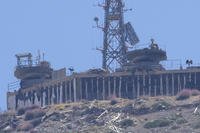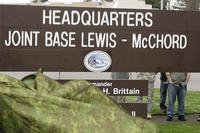Six years after the federal government learned that the Niagara Falls Air Reserve Station was one of the worst polluted military sites in the nation with PFAS, it still has no cleanup plans.
The ubiquitous and insidious per- and polyfluoroalkyl chemicals are present in groundwater at the station in levels up to 300,000 times greater than drinking water standards set by the U.S. Environmental Protection Agency, according to studies conducted by a consultant for the military.
The pollution came from foam, called aqueous film-forming foam, or AFFF, that firefighters used mostly in training activities at the station from the 1960s through late 1990s.
PFAS chemicals have since made their way into Cayuga Creek, according to studies by Buffalo Niagara Waterkeeper and the state Department of Environmental Conservation. The creek runs through the station and is a tributary of the Niagara River and Lake Ontario, a major drinking water source for thousands of people in the United States and Canada.
The chemicals particularly concern scientists because they bioaccumulate − meaning the body doesn't flush them out like it would other contaminants − earning them their colloquial name, "forever chemicals."
Exposure to them has been linked to increased chances of getting some types of cancer, suppressed immune functions, small decreases in birth weights, increases in cholesterol levels, and pregnancy-induced hypertension and preeclampsia, according to the Agency for Toxic Substances and Disease Registry.
"The DAF ( Department of the Air Force) has not established a time-line for possible clean-up actions" for the PFAS found at the Niagara Falls Air Reserve Station, Lindsay Mairs, a remedial program manager for the Air Force, wrote in an email to The Buffalo News. "But we always have the ability to take immediate action if we identify an imminent risk to human health."
Low levels of PFAS chemicals have been detected in the drinking water provided by the Niagara Falls Water Board, which serves about 50,000 people. The water purveyor takes its water from the Niagara River directly downstream of Cayuga Creek, according to Sean Costello, executive director of the Water Board.
The board's water treatment system has kept PFAS levels in its customer's drinking water below EPA and New York State Department of Health standards since it began testing in 2021.
But drinking water isn't the only victim to the PFAS pollution.
Buffalo Niagara Waterkeeper has found high levels of PFAS chemicals in the surface water of Cayuga Creek downstream of the Niagara Falls Air Reserve Station at Porter Road. Up to 147.7 parts per trillion of a PFAS chemical were detected in the creek's surface water − one of the highest detections of 114 waterways sampled by waterkeeper organizations around the nation in 2022.
Additionally, the state DEC found levels of PFAS of up to 3,960,000 ppt in fish from the creek during surveys in 2019. There is an existing advisory for Cayuga Creek warning people to not eat any fish from the creek due to elevated levels of PCBs and dioxins found in the animals.
"PFAS are in our water, they're in our blood, they're in our wildlife, they're in our food we eat," Waterkeeper Executive Director Jill Jedlicka said. "But we know where it's coming from. And we know how to stop it."
Longstanding PFAS use
PFAS pollution was found at high levels in the surface water, groundwater and soil at the Niagara Falls Air Reserve Station in several areas where the AFFF used by firefighters leaked or was likely directly sprayed on the ground.
The chemicals also are found in many household items, including non-stick cookware, dental floss, waterproof makeup and smartphone screens.
Studies conducted by chemical manufacturers 3M and DuPont in the 1950s and 1960s found PFAS could be toxic to humans, but such information was kept private.
U.S. Department of Defense studies conducted beginning in the 1970s showed that the PFAS-containing AFFF used on military bases to fight fires was toxic, according to documents obtained by the nonprofit Environmental Working Group. By the 1980s, the agency said it had evidence that PFAS chemicals could pose environmental and health risks.
PFAS were used in firefighting foam because they are particularly effective at putting out petroleum fires. The foam's use at airports around the nation has led to new and widespread efforts to identify which airports have PFAS contamination issues. In some cases, entire city or town drinking water sources have been polluted with PFAS leaching from airports.
Public concern over the substances' toxicity began in the 1990s, after news broke that PFAS were found to contaminate water near a 3M plant in West Virginia.
The EPA didn't implement drinking water standards for some PFAS chemicals until April. In the standards, the agency acknowledged there is no safe level of exposure to PFOA and PFOS, the most commonly found of the thousands of synthetic chemicals that fall under the PFAS umbrella, but set the limit each could be in drinking water at 4 ppt.
U.S. Department of Defense officials issued a rule in 2023 prohibiting any use of AFFF after Oct. 1 at any military installation.
The Niagara Falls Air Reserve Station expects to receive firefighting foam free of PFAS, called fluorine-free foam or F3, later this summer, according to station Fire Chief Aaron McLane. The foam is being rolled out at airports around the nation.
AFFF hasn't been used at the Niagara Falls Air Reserve Station since the 1990s, but it has been kept on site in case of emergencies, McLane told The News in a written statement.
More testing scheduled
Testing completed in 2018 found PFOA and PFOS combined in groundwater at a firefighter training area at the station in levels up to 1,310,000 ppt. Six other spots on the property had PFAS detections in groundwater at the time ranging from 7.7 ppt to 49,000 ppt, according to reports prepared by an engineering firm for the U.S. Army Corps of Engineers.
Those detections placed the Niagara Falls Air Reserve Station as the seventh-most PFAS polluted military installation in the United States, according to a 2019 list by EWG.
A contract to conduct further testing and determine the full extent of PFAS pollution at the air reserve station was awarded in 2022, according to Mairs. The results of such testing have not yet been released publicly.
More site testing is planned for 2026. This round of testing will "determine any unacceptable risk from PFAS at these sites, which will inform need for any cleanup remedies needed at this site," Mairs told The News.
Because of the chemicals' prevalence, the Niagara Falls Air Reserve Station isn't the only source of PFAS in the Niagara River, Jedlicka said, but it's a source that has been identified and found to have direct impacts on Cayuga Creek.
"With a source area that is flaming hot right now, 1.3 million parts per trillion," she said, "that's a source area that needs to be remediated or all that's going to continue to leach through Cayuga Creek into where the drinking water intakes are."
___
(c)2024 The Buffalo News (Buffalo, N.Y.)
Visit The Buffalo News (Buffalo, N.Y.) at www.buffalonews.com
Distributed by Tribune Content Agency, LLC.











